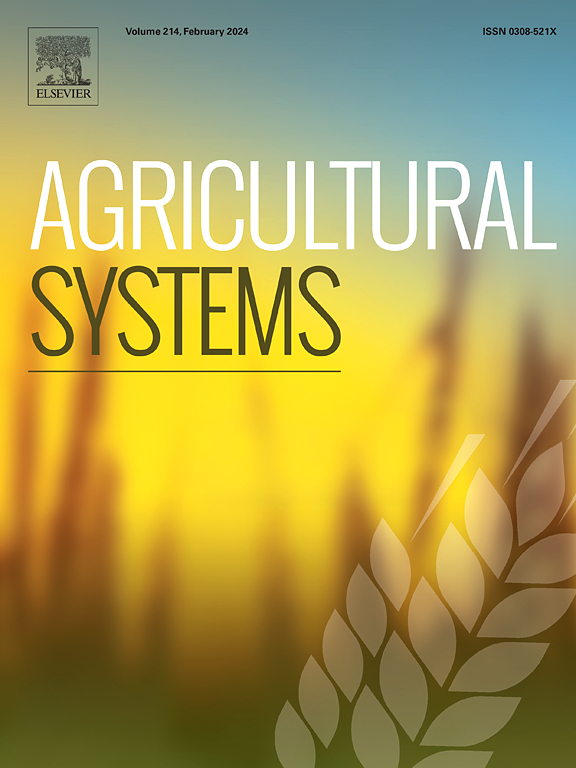Why AWD isn't taking off: Understanding barriers and pathways for scaling in gravity-fed irrigation systems in rice landscape
IF 6.1
1区 农林科学
Q1 AGRICULTURE, MULTIDISCIPLINARY
引用次数: 0
Abstract
CONTEXT
Alternate Wetting and Drying (AWD) offers considerable potential to reduce water use and methane emissions in irrigated rice systems without compromising yields. However, despite decades of promotion, AWD adoption remains limited, especially in gravity-fed irrigation systems where institutional and agro-environmental complexities pose challenges to implementation.
OBJECTIVE
This study assessed the biophysical, socio-economic, and institutional determinants of AWD adoption at the turnout level in a gravity-fed irrigation system in Nueva Ecija, Philippines. The aim was to identify key barriers and opportunities for scaling AWD under spatially heterogeneous and rotationally scheduled irrigation conditions.
METHODS
Six turnouts within the Lateral G canal of the Upper Pampanga River Integrated Irrigation System were selected. Data were collected on plot elevation, soil texture, ownership patterns, water application, and grain yield. Water governance structures were analysed through focus group discussions and interviews with stakeholders. A decision logic framework was used to classify AWD adoption based on field-level water depth measurements.
RESULTS AND CONCLUSIONS
AWD reduced irrigation input by 21 % in the dry season and 50 % in the wet season while maintaining yields. However, adoption was constrained by elevation-driven water flow patterns, clay distribution, tenant-operated plots, and rigid rotational schedules. AWD adoption was more feasible during the wet season due to reduced irrigation risk. Weak farmer engagement in decision-making limited field-level adaptability.
SIGNIFICANCE
Scaling AWD requires reconfigured irrigation governance, integration of real-time water monitoring technologies, and economic incentives such as carbon financing. Context-specific, multi-level interventions are essential to enable large-scale AWD implementation in gravity-fed systems.

为什么AWD没有发展起来:了解水稻景观中重力灌溉系统的障碍和途径
在不影响产量的情况下,交替干湿(AWD)在减少灌溉水稻系统的用水量和甲烷排放方面具有相当大的潜力。然而,尽管已经推广了几十年,AWD的采用仍然有限,特别是在制度和农业环境复杂性对实施构成挑战的重力灌溉系统中。目的:本研究评估了菲律宾Nueva Ecija一个重力灌溉系统在投票率水平上采用AWD的生物物理、社会经济和制度因素。目的是确定在空间异质性和轮作灌溉条件下扩大AWD的主要障碍和机会。方法选取邦板牙河上游综合灌溉系统侧G渠内的6个水点。收集了小区高程、土壤质地、所有制模式、水分施用和粮食产量等方面的数据。通过焦点小组讨论和与利益相关者的访谈,分析了水治理结构。基于现场水深测量,采用决策逻辑框架对AWD的采用进行分类。结果与结论sawd在保持产量的情况下,旱季和雨季灌溉投入分别减少21%和50%。然而,采用受到海拔驱动的水流模式、粘土分布、租户操作的地块和严格的轮换时间表的限制。由于灌溉风险降低,在雨季采用AWD更为可行。农民决策参与度低,限制了田间水平的适应性。扩大AWD需要重新配置灌溉治理,整合实时水监测技术,以及碳融资等经济激励措施。根据具体情况,多层次的干预措施对于在重力供油系统中大规模实施AWD至关重要。
本文章由计算机程序翻译,如有差异,请以英文原文为准。
求助全文
约1分钟内获得全文
求助全文
来源期刊

Agricultural Systems
农林科学-农业综合
CiteScore
13.30
自引率
7.60%
发文量
174
审稿时长
30 days
期刊介绍:
Agricultural Systems is an international journal that deals with interactions - among the components of agricultural systems, among hierarchical levels of agricultural systems, between agricultural and other land use systems, and between agricultural systems and their natural, social and economic environments.
The scope includes the development and application of systems analysis methodologies in the following areas:
Systems approaches in the sustainable intensification of agriculture; pathways for sustainable intensification; crop-livestock integration; farm-level resource allocation; quantification of benefits and trade-offs at farm to landscape levels; integrative, participatory and dynamic modelling approaches for qualitative and quantitative assessments of agricultural systems and decision making;
The interactions between agricultural and non-agricultural landscapes; the multiple services of agricultural systems; food security and the environment;
Global change and adaptation science; transformational adaptations as driven by changes in climate, policy, values and attitudes influencing the design of farming systems;
Development and application of farming systems design tools and methods for impact, scenario and case study analysis; managing the complexities of dynamic agricultural systems; innovation systems and multi stakeholder arrangements that support or promote change and (or) inform policy decisions.
 求助内容:
求助内容: 应助结果提醒方式:
应助结果提醒方式:


